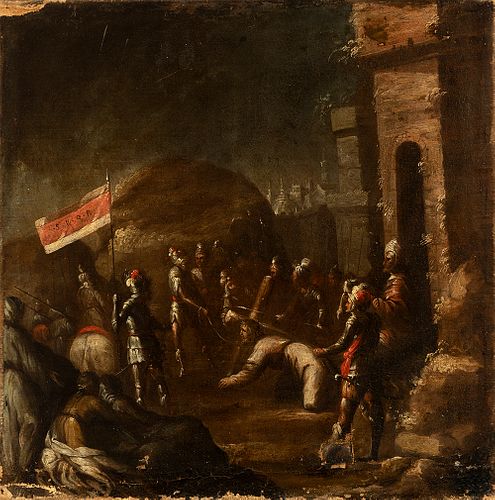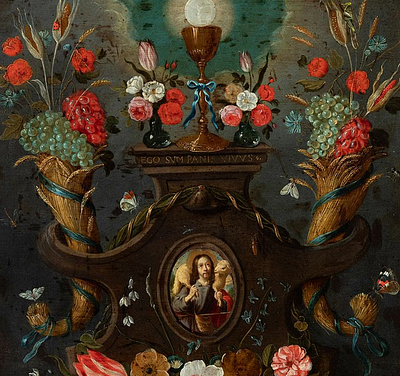Workshop of ANTONIO DEL CASTILLO Y SAAVEDRA (Cordoba, 1616 - 1668). "Fallen on the Road to Calvary". Oil on canvas. Relined.
Lot 27
About Seller
Setdart Auction House
Carrer Aragó 346
Barcelona
Spain
Setdart Subastas was born in 2004 and is currently the first online art auction in Spain with solidity, prestige and reliability guaranteed by our more than 60,000 users. Setdart has a young, dynamic and enterprising team ready to successfully manage the purchase and sale of art works through custom...Read more
Estimate:
EUR€2,000 - EUR€3,000
$2,105.26 - $3,157.89
Absentee vs Live bid
Two ways to bid:
- Leave a max absentee bid and the platform will bid on your behalf up to your maximum bid during the live auction.
- Bid live during the auction and your bids will be submitted real-time to the auctioneer.
Bid Increments
| Price | Bid Increment |
|---|---|
| EUR€0 | EUR€10 |
| EUR€200 | EUR€25 |
| EUR€500 | EUR€50 |
| EUR€1,000 | EUR€100 |
| EUR€3,000 | EUR€200 |
| EUR€5,000 | EUR€500 |
| EUR€10,000 | EUR€1,000 |
| EUR€20,000 | EUR€2,000 |
| EUR€50,000 | EUR€5,000 |
About Auction
By Setdart Auction House
Sep 21, 2021
Set Reminder
2021-09-21 10:00:00
2021-09-21 10:00:00
America/New_York
Bidsquare
Bidsquare : 21st September - ARAS JÁUREGUI Private Collection - Old Masters, 19th & 20th Century
https://www.bidsquare.com/auctions/setdart-auction-house/21st-september---aras-j-uregui-private-collection---old-masters-19th-20th-century-7429
Setdart Auction House sofia@setdart.com
Setdart Auction House sofia@setdart.com
- Lot Description
Workshop of ANTONIO DEL CASTILLO Y SAAVEDRA (Cordoba, 1616 - 1668). "Fallen on the Road to Calvary". Oil on canvas. Relined. Measurements: 60,5 x 100,5 cm. Exhausted by the blood lost in the scourging, weakened by the physical and moral sufferings that had been inflicted on him the night before, and without having slept, Jesus could hardly take a few steps and soon fell under the weight of the cross. Then followed the beatings and humiliations of the soldiers, the expectant laughter of the crowd. The Messiah, with all the strength of his will and with all his might, managed to get up and continue on his way. According to theological interpretations, Jesus invites us by his actions to carry our cross and follow him, he teaches us here that we too can fall, and that we must understand those who fall; that none of us must remain prostrate, we must all get up with humility and trust, seeking his help and forgiveness. In this particular work, the figure of Christ is in the centre of a composition, conceived as a frieze, to allow a simple reading of the theme. The work belongs to a group representing the scenes of the Way of the Cross. This format was common to Antonio del Castillo, an example of which is his series on Saint Joseph. Antonio Castillo is considered to be the father of the Cordovan school of painting. He was also a polychromator and designer of architectural, decorative and goldsmithing projects. He was the son of Agustín del Castillo, a little-known painter from Llerena (Extremadura) whom Palomino describes as "an excellent painter". It is also thought that he may have trained as a polychromator in Calderón's workshop. However, he was orphaned when he was only ten years old in 1626 and went on to train in the workshop of another painter of whom we have no record, Ignacio Aedo Calderón. Although there is no real evidence of this, it is thought that he may have arrived in Seville, where, according to Palomino, he entered Zurbarán's workshop. This has been corroborated by the stylistic influence of the Extremaduran master that historians have seen in Castillo's work. However, in 1635 he returned to his native Cordoba, where he married and settled permanently, eventually becoming the city's most important artist without question. His fame and quality earned him important commissions, including religious altarpieces, portraits and medium-format series. He was also the teacher of outstanding Cordoban painters of the following generation, such as Juan de Alfaro and Gámez. With regard to his language, Antonio del Castillo did not develop an obvious evolution in his work, although towards the end of his life a more softened language can be discerned, and he remained on the fringes of the baroque innovations of other contemporary painters. However, like the rest of his contemporaries, he was seduced by the novelty of Murillo's work and in his last years introduced the Venetian chromatic softness of the Sevillian master. Generally speaking, in his religious figures he remained closer to strict naturalism, while in his historical compositions he tended to be more open, particularly when adding architecture and landscapes to his paintings. Palomino praised his ability to capture nature, describing him as "an excellent landscape painter, for which he used to go out for a few days on a walk on a sketching errand and copy some places from nature. This note by the treatise writer shows Antonio del Castillo to be a painter particularly interested in depicting nature, something that is evident not only in his landscapes but also in the everyday figures and animals that populate many of his works. There are also numerous drawings by his hand in which he depicts nature, characters and animals with great skill and immediacy.
- Shipping Info
-
In-house shipping available. Please inquire at admin@setdart.com.
-
- Buyer's Premium



 EUR
EUR CAD
CAD AUD
AUD GBP
GBP MXN
MXN HKD
HKD CNY
CNY MYR
MYR SEK
SEK SGD
SGD CHF
CHF THB
THB
















